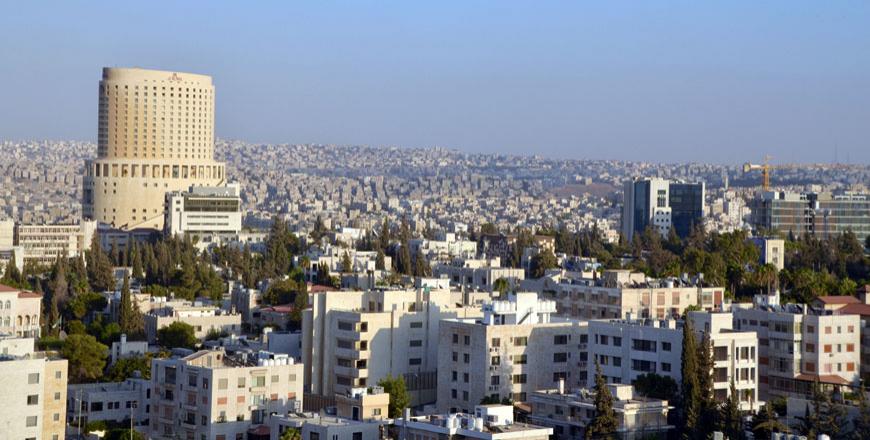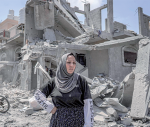You are here
All agree on need to improve east Amman’s conditions, but actual steps yet to materialise
By Dana Al Emam - Sep 02,2015 - Last updated at Sep 02,2015

This recent photo taken from a location in west Amman shows on the horizon the less developed eastern parts of the city (Photo by Muath Freij)
AMMAN — The air in west Amman feels a little fresher for Mohammad Ayyad, a resident of the capital's eastern Hashemi Shamali neighbourhood.
"There is a lot to do in west Amman; it is less crowded and has more developed facilities," the 21-year-old told The Jordan Times, adding that he makes a 20-minute-trip every Friday morning to Al Hussein Park with several friends to play football.
After university lectures, Ayyad usually spends most of his time at cafés surrounding the university to get together with friends, study and work on projects.
"There is not much to do in the eastern parts of the city," he said, adding that basic services like street pavement, water supply and sanitation are in a much better condition in west Amman.
"There are tens of housing complexes all along the street I live in, and each complex consists at least of eight small apartments," he said, adding that hundreds of families in his area "have no breathing space or a public park to relieve stress".
Meanwhile, Alaa Talhouni, a resident of the Seventh Circle neighbourhood in west Amman, said services and development levels should be equal all over the city as residents pay equal taxes regardless of where they live.
"The western areas of Amman are becoming more crowded as residents of the eastern parts have limited or no entertainment facilities," she said, noting that western areas do not have "sufficient" facilities in the first place.
The level of services must not be determined according to the financial status of residents, Talhouni noted, adding that she sees a "gap" in development between the two sides of the city when she visits her brother who lives in Jabal Nuzha.
Remarks of Ayyad and Talhouni seem to touch on a development issue affecting residents in both east and west Amman.
At a meeting with Amman dignitaries, leading figures and military veterans at the Royal Court earlier this week, His Majesty King Abdullah highlighted the need for further focus on east Amman and the development of the Madouneh area to the east of the capital through coordination between the government and the armed forces.
Meanwhile, in a statement e-mailed to The Jordan Times upon request, deputy mayor of the Greater Amman Municipality (GAM) Yousef Shawarbeh said GAM is keen on implementing Royal directives regarding improving the level of services for citizens in Amman, especially east Amman.
He added that GAM has started preparing a comprehensive development and service plan for east Amman in March, noting that work is under way to establish the “cars city”, a 1,000 dunum project with an open area for car exhibitions and garages that is expected to provide 1,000 job opportunities.
Furthermore, GAM seeks to establish a new 100-dunum slaughterhouse in the Madouneh area, a project that is expected to bring in several investment opportunities of concerned firms. In addition, the municipality plans to implement several projects for gardens, parks and playfields in east Amman.
He noted that GAM’s 2025 plan seeks to enhance development and expansion of the city towards the east and south, and to encourage investments in these areas.
GAM, Shawarbeh said, provides all possible facilities for investment projects in the east of the capital to further develop the area and generate jobs.
Commenting on the issue, Jawad Anani, economist, former Royal Court chief and a severAl time minister, said some areas in Amman do not represent the image of what a capital should look like.
Furthermore, he linked between providing entertainment outlets and facilities for the young generation and the fight against extremism, as youths struggling with social injustice are easy targets for extremist groups.
Poverty in underdeveloped areas in east and south Amman is another issue to be addressed, said Anani, who added that combating poverty programmes mostly target governorates, although some neighbourhoods in Amman are in worse condition.
These areas, which highly depend on informal economies and craftsmanship, have “great” potential for investment projects that employ residents’ skills to generate income and improve living standards, he added.
Anani said establishing a “creativity-encouraging” fine arts institute would help enhance and pass on these skills.
In an interview with The Jordan Times on Tuesday, Jordan Investment Commission (JIC) President Montasser Oqlah highlighted the commission’s belief in the importance of even distribution of development gains across the Kingdom.
He added that the JIC is currently working on a bylaw to further cut income taxes for investment projects in “underprivileged” areas, adding that the investment opportunity is what attracts investments, not any administrative or political decision.
Related Articles
AMMAN — The Greater Amman Municipality (GAM) on Sunday said it has “temporarily” suspended its plans for the “Madouneh Project”, aimed at re
AMMAN — The Greater Amman Municipality (GAM) Council has approved an agreement to develop, invest and manage GAM’s assets and investment rig
AMMAN — A $1.5 billion tourism project will be established on 2,000 dunums of land at the Dead Sea under an agreement signed on Sunday, the















